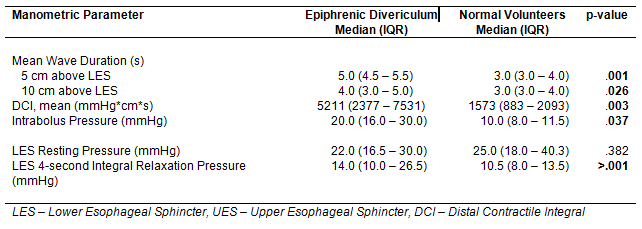Dylan R Nieman, MD, PhD, Michal J Lada, MD, Michelle Han, MD, Poochong Timratana, MD, Christian G Peyre, MD, Carolyn E Jones, MD, Thomas J Watson, MD, Jeffrey H Peters, MD
University of Rochester
INTRODUCTION: Esophageal epiphrenic diverticulum (EED) is an uncommon manifestation of esophageal disease that has been variously associated with esophageal motility disorders. The development of high resolution manometry (HRM) has allowed for the precise classification of esophageal dysfunction. Our aim was to characterize the HRM findings that are associated with EED.
METHODS AND PROCEDURES: Nine patients (mean age 71.5 ± 9.0 years; mean BMI 27.5 ± 4.8; 6 female), with radiographic evidence of EED who underwent HRM from 2008 through 2011 were reviewed. Manometry studies were re-analyzed using current esophageal motility classifications and updated analysis software (ManoView™ v3.0), Measurement parameters were compared with previously established normal reference values from our institution as well as with the re-analyzed HRM studies of twenty normal volunteers. Non-parametric univariate analysis of data was performed with Mann-Whitney U-test.
RESULTS: All patients demonstrated manometric evidence of hypertensive esophageal body contraction (average distal contractile integral (DCI) > 5000 mmHg*cm*s) and/or functional outflow obstruction (elevated intra-bolus pressure (IBP) and/or elevated 4-second integrated relaxation pressure (IRP)). Three patients showed functional outflow obstruction alone, two patients hypertensive esophageal body contraction alone, and five patients showed evidence of both. On univariate analysis of manometric parameters with respect to normal volunteers, patients with EED had significantly elevated lower esophageal sphincter IRP, IBP, DCI and wave duration (Table).
CONCLUSION: Esophageal dysfunction was present in all patients, with significant abnormalities of the esophageal body, gastroesophageal junction, or both. The pathophysiology of EED has been explained as the formation of a pulsion diverticulum secondary to an underlying esophageal motility disorder. These data provide evidence for that mechanism, demonstrating prolonged, hypertensive esophageal body contraction and/or elevated esophageal outflow resistance in all patients studied.
Session: Poster Presentation
Program Number: P232

